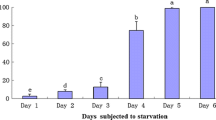Abstract
Juvenile shrimp, Crangon crangon L., were maintained in water-soluble crude oil fractions at 10°, 15° and 20°C. During chronic exposure to oil fractions, a reduction in respiration and growth rate occurred which was related to strength of the extract. Mortality increased with strength of oil fraction and was highest at 20°C. Calculation of carbon budgets indicated that the extract reduced net carbon turnover at each temperature. Physiological consequences resulting from exposure to the oil fractions are discussed.
Similar content being viewed by others
Explore related subjects
Discover the latest articles and news from researchers in related subjects, suggested using machine learning.Literature Cited
Anderson, J.W., J.M. Neff, B.A. Cox, H.E. Tatem and G.N. Hightower: The effects of oil on estuarine animals: toxicity, uptake and depuration, respiration. In: Pollution and physiology of marine organisms, pp 285–310. Ed. by J.F. Vernberg and G.M. Vernberg. New York: Academic Press 1974a
—————, J.M. Neff, B.A. Cox, H.E. Tatem and G.N. Hightower: Characteristics of dispersions and water-soluble extracts of crude and refined oils and their toxicity to estuarine crustaceans and fish. Mar. Biol. 27, 75–88 (1974b)
Blumer, M., J.M. Hunt, J. Atema and L. Stein: Interaction between marine organisms and oil pollution. Publs U.S. envir. Prot. Ag., ecol. Res. Ser. No. EPA-R3-73-042, 1–97 (1973)
—, S. Souza and J. Sass: Hydrocarbon pollution of edible shellfish by an oil spill. Mar. Biol. 5, 195–202 (1970)
Corner, E.D.S., C.C. Kilvington and S.C.M. O'Hara: Qualitative studies on the metabolism of naphthalene in Maia squinado (Herbst). J. mar. biol. Ass. U.K. 53, 819–832 (1973)
Cox, B.A. and J.W. Anderson: Some effects of #2 fuel oil on the brownshrimp Penaeus aztecus. Am. Zool. 13, p. 1308 (1973)
Dow, R.L.: Reduced growth and survival of clams transplanted to an oil spill site. Mar. Pollut. Bull. 6 (8), 124–125 (1975)
Edwards, R.R.C., D.M. Finlayson and J.H. Steele: An experimental study of the oxygen consumption, growth and metabolism of the cod (Gadus morhua L.). J. exp. mar. Biol. Ecol. 8, 299–309 (1972)
Gilfillan, E.S.: Decrease of net carbon flux in two species of mussels caused by extracts of crude oil. Mar. Biol. 29, 53–57 (1975)
—, D. Mayo, S. Hanson, D. Donovan and L.C. Jiang: Reduction in carbon flux in Mya arenaria caused by a spill of No. 6 fuel oil. Mar. Biol. 37, 115–123 (1976)
Hagerman, L.: The oxygen consumption of Crangon vulgaris (Fabricius) (Crustacea, Natantia) in relation to salinity. Ophelia 7, 283–292 (1970)
—: The respiration during the moult cycle of Crangon vulgaris (Fabr.) (Crustacea, Natantia). Ophelia 15, 15–21 (1976)
Katre, S. and S.R. Reddy: Laboratory studies on food intake, growth and conversion efficiency of Palaemon lamarrei in relation to body size. Aquaculture 11, 247–261 (1977)
Lloyd, A.J. and C.M. Yonge: The biology of Crangon vulgaris L. in the Bristol Channel and Severn Estuary. J. mar. biol. Ass. U.K. 26, 626–661 (1944)
Meixner, R.: The effects of food supply on moulting, growth and spawning of the shrimp Crangon crangon L. Int. Coun. Explor. Sea. Comm. Meet. 1966 (M:5), 1–7 (1966)
Nelson-Smith, A.: Oil pollution and marine ecology, LX+220 pp. New York: Plenum Press 1973
Smith, J.E.: Torrey Canyon pollution and marine life, Vol. 14. 196 pp. Cambridge: Cambridge University Press 1970
Steele, J.H.: The structure of marine ecosystems, 128 pp. Cambridge, Mass.: Harvard University Press 1974
Author information
Authors and Affiliations
Additional information
Communicated by J. Mauchline, Oban
Rights and permissions
About this article
Cite this article
Edwards, R.R.C. Effects of water-soluble oil fractions on metabolism, growth and carbon budget of the shrimp Crangon crangon . Mar. Biol. 46, 259–265 (1978). https://doi.org/10.1007/BF00390687
Accepted:
Issue Date:
DOI: https://doi.org/10.1007/BF00390687




